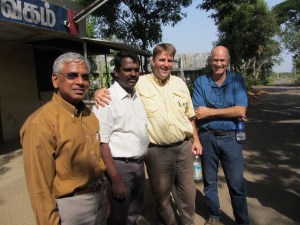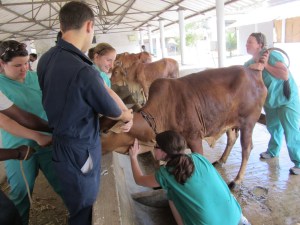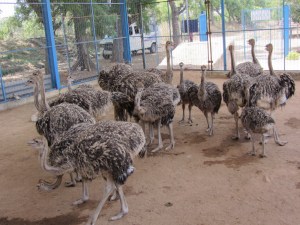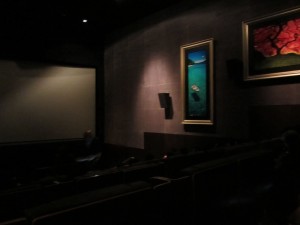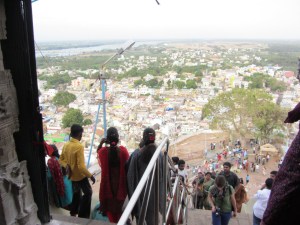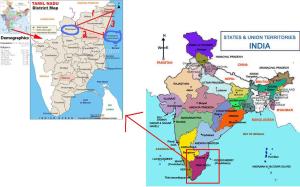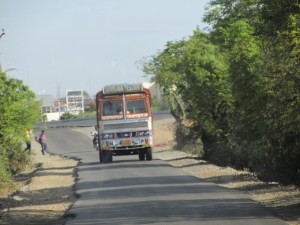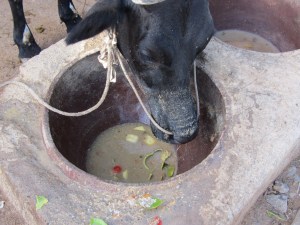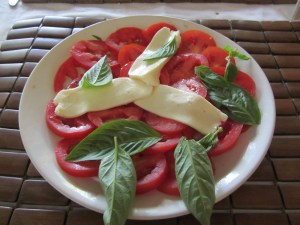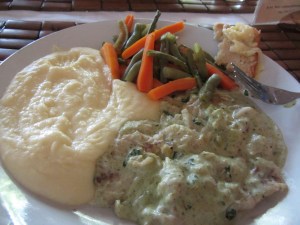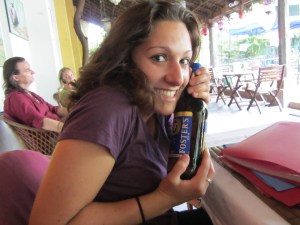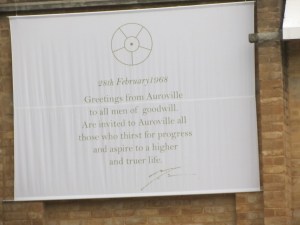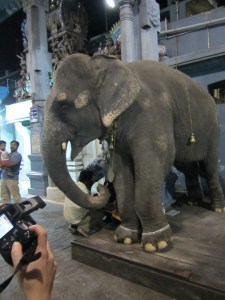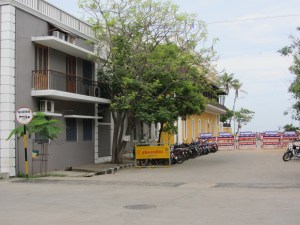Category Archives: temples
India 2, Sara 0
 The Daily Moo…which isn’t so daily: Gir breed cattle
The Daily Moo…which isn’t so daily: Gir breed cattle
I am unhappy to announce that India has once again got the better of me and I’m on round #2 of traveler’s sickness. I was debating whether or not to just launch into the past week’s events or to disclose that little tidbit, but I think it makes for an interesting story. I aim to include all of my experiences in India, whether they be good, bad, or ugly (like this).
Getting sick is particularly distressing to me because in the States I rarely ever get sick, and I’m a stubborn SOB. I won’t show that I’m sick until I’m reeeaally feeling it and always try to jump back into things too fast. I’m not one for being babied and dragging it out. And I really, really don’t like it when all attention is on me…which tends to happen when you are the only white person in an Indian hospital. Yesterday, I had that great pleasure.
I started feeling sick in the morning. I couldn’t get cool and my head felt like a giant boulder on my shoulders at breakfast. Saturday I felt completely fine…the last time I had had any problem was the Tuesday before, when I had a mild fever and nothing else. It passed uneventfully. Sunday felt like that, only worse. I just couldn’t sit upright for very long and got extremely lightheaded and sweaty after even mild physical exertion. I decided to stay in the back of our 14 passenger van and lay across the seats in the air conditioning rather than visit the 1,000 year old temple which was next on our list. More on that later.
After passing up some other activities, our guide Dr. Balakrishnan decided that we would stop by one of the local hospitals and get me checked out. I couldn’t hear very well in the back of the van so I didn’t get a chance to protest, and next thing I know I’m there. I still don’t really think I needed to go to the hospital, as I was suspecting another case of traveler’s sickness. But I didn’t like the fact that I was sick last Tuesday as well and this was my 2nd bout of it. It made me worried to have a fever that often.
The nurses, like people do everywhere else, stared. This threw me off since I wasn’t feeling well and wasn’t up for staring, but they were very nice. The hospital was a relatively small, one story building open to the air with a bunch of exam rooms and a waiting area visible. I think this was more of a community hospital, like Lansing Urgent Care, than an actual big time hospital. I didn’t see too many high tech devices or too many rooms, but then again I was mostly just trying to figure out what was going on.
I got ushered around back to sit in the open air waiting room for my appointment, which came quickly. The doctor was an older gentleman who spoke English decently well, and asked me “how I liked India.” Bad time to ask, buddy. He listened to my heart, lungs and GI system, took a glance at my tongue, listened to my symptoms and diagnosed food borne sickness. I’m still not quite sure that that’s what it is, but he seemed pretty sure of it. I was thrown off by the fact that he didn’t ask for my drug allergies or current meds before prescribing a bunch of drugs, including an IV injection of some fever reducer and an antibiotic. The whole experience made me a little wary, but at least I’m at home now, and alive. I made sure to search my take home meds online, since I didn’t want to just be taking antibiotics willy nilly and all of the instructions were in Tamil.
Our group had joked at the airport on our first day together that one of us would have to visit the hospital just to see what it was like, and I got to be the lucky one. So…if this entry seems a bit negative…it’s just the sickness talking. I’m trying to remain positive in light of being sick three times, losing my luggage and just generally sweating all the time, but sometimes it’s hard. Don’t get me wrong, I’m sure at the end of this trip I’ll be extremely happy that I went and will realize all the things I’ve learned here. Just writing this blog helps me appreciate it. It’s just hard to see past my 103 fever from yesterday.
One thing I know for sure…I have never loved and appreciated the United States more than I do now. I miss driving my car, the food, the cleanliness of restaurants and homes, the foliage, the quiet, the clean smell of alcohol in hospitals…lots of things. I love a lot of things about India, too, but this place sure does make you homesick.
Now on to what happened the rest of the week.
Monday and Tuesday were mostly sample collection, going to the clinic in the morning and running tests in the afternoon. We saw a calf with an umbilical hernia, a cow with rumen acidosis, a cow with an interdigital abscess, a horse with forelimb tendonitis, a horse with saddle sores and a dog with subcutaneous emphysema. This condition occurs when air gets trapped between the dermis and faschia, which is the connective tissue which covers muscle and other things in the body. Air is generally introduced from the outside, such as when an animal’s trachea is punctured. That was the case with this poor pup, who was grabbed by the neck by another dog and developed the emphysema shortly afterward. You could feel the crepitus; air crackling under his skin all over his body. He felt like touching bubble wrap. To fix it, the doctor made three small incisions over his dorsum and released most of the air. It was something I’ve never seen before, and don’t know if I’ll ever see again.
The rest of the cases were your run of the mill mastitis, abortions, rumen impactions, not eating, etc.
Wednesday we headed to the veterinary school’s organized farm in Mahabdipurum (sp?) for sample collection. The farm is about an hour and a half away in a beautiful, breezy, mountainous area. It houses an ostrich breeding facility, sheep, pig, goat and cattle farm, “slaughter hall” (aka pathology lab) and a place to get lunch. A group of 50 veterinary students came with us to help us restrain the cattle, since there were no chutes or holding pens. We just manhandled them into corners and a few people held while someone else stuck. We were also forced to get blood with vacutainer needles that had no hubs…you know, the plastic pieces which make it so that you don’t stick yourself. All in all, it was a challenging but rewarding experience. We certainly felt like field vets after that one…improvisation is key!
After lunch, I visited the slaughter hall where our pathologist friend Ron (from across the way in the guy’s hostel) was doing his work. His project involves testing a vaccine for Johne’s disease on a flock of Madras Red sheep.
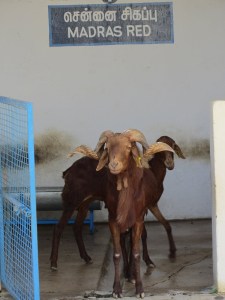 Unfortunately, like with many research projects, his trial required sacrificing the sheep, and this week was that week. After the act was done, he would have to perform necropsies and detail his findings. I could tell it was a hard experience for Ron, since he knew the sheep well even though they were never named. They also didn’t use a captive bolt gun on them before decapitation (they were slaughtered in a way similar to Halal slaughter). It was definitely hard to watch, but was over quickly and seemed relatively painless. We said a prayer for them before they were sacrificed. They also saved all the meat for consumption, which made everything seem a bit better. At least every bit of the sheep were used.
Unfortunately, like with many research projects, his trial required sacrificing the sheep, and this week was that week. After the act was done, he would have to perform necropsies and detail his findings. I could tell it was a hard experience for Ron, since he knew the sheep well even though they were never named. They also didn’t use a captive bolt gun on them before decapitation (they were slaughtered in a way similar to Halal slaughter). It was definitely hard to watch, but was over quickly and seemed relatively painless. We said a prayer for them before they were sacrificed. They also saved all the meat for consumption, which made everything seem a bit better. At least every bit of the sheep were used.
From left: Dr. Namalawar Srirangnathan, Dr. Bala Supramanion, Dr. Ron Tyler Jr., Dr. Ron Tyler Sr.
The necropsy lab was a far cry from DCPAH, but it was cool to see. The attendants walked around barefoot and didn’t wear gloves, but Ron and his father Ron Sr.(also a pathologist) did. There was a big cutting block that was literally a tree stump, and a stainless steel table. It was incredibly well ventilated and real sunlight flowed in. They used a Bunsen burner or something like it to sterilize instruments and Ron provided his own whirl bags and other things for samples. He made sure all samples were embedded in paraffin for their journey to the US. While we were there, they found tapeworm cysts in the bellies of two of the sheep. It was pretty disgusting, but being a path nerd, I was excited.
Thursday was a visit to another university farm, but this time it included just us, Dr. Balakrishnan and our friend Gowri. We got our hands a bit more dirty manhandling the cows on our own, without the help of the students. It was empowering to be able to collect blood without a chute; to watch the cows’ body language and restrain with our very own hands. Dangerous, yes, but good practice getting blood in a difficult situation.
Some differences that we observed between US and Indian ag over the last week:
-In pig raising, there are no farrowing crates. Pigs farrow on the ground and have an open pen to raise the piglets in. They raised Yorkshire pigs at the university farm we visited, but crossbred to Durocs and other hardy breeds for parasite resistance. Breeding is done through natural service. The pigs are allowed to wallow around in water troughs, but there is no dirt for rooting. Of course, this was a more modernized, university farm. Most pig farms are not modernized and the pigs are just allowed to roam freely around the farm, rooting and having babies wherever and living outside. These pigs at the university were being raised as breeding stock for farmers to start their own pig farms, so they were kept more confined.
 Yorkshire in pink, crossbred in spots
Yorkshire in pink, crossbred in spots
-With ostrich farming, the animals are kept for meat, eggs and leather. They have two toes, and emus have three. They’re just like big chickens…they walk around and peck the ground and fan themselves with massive wings. Not much more to say on them…
-Sheep and goats are numerous everywhere, and do quite well in the heat (except the wool breeds, which aren’t very common in India). Most of the sheep and goats I saw were in great shape, feeding on all of the shrubbery, weeds and grass around. They are often lead to an area to graze, and fed extra fodder for needed protein, etc. They kid and lamb year round since the weather is always warm. The kids may or may not be kept under little woven huts to protect them from predators at night. At the farm we visited, the gentleman vaccinated for entertoxemia (Clostridium perfringens type D), PPR? which is a disease like Rinderpest which isn’t in the US, and one other thing which is escaping my memory right now. They don’t vaccinate for Tetanus like in the US.
-Cattle are kept either in confinement, tied to something, or allowed to freely roam around the yard. They are often walked somewhere for grazing, and may or may not be given ad libitum water. They are hand milked and calves are allowed to stay on them until they reach a decent size. Many cattle are bred by A.I., even in the villages. Cattle are kept until they have calved about 6 times, and since the intercalving interval is about 2 years, this can mean about 12-14 years old (as compared to the 4-6 in America). They may be vaccinated for blackleg, Foot and Mouth or hemorrhagic septicemia, and they may or may not be dewormed. You can acquire cattle through private trade or a shanty (similar to an auction).
 Hand milker and calf with a common goal…get milk
Hand milker and calf with a common goal…get milk
-Chickens in intensively raised farms are kept much the same way as American chickens; on grated floors in small cages where the eggs roll away from them into an egg collection trough. The farm we saw had a well lit and breezy barn with an assortment of laying hens in such cages. Bigger cages held roosters and other breeds. The chickens didn’t have much space, but they seemed generally happy and clean. In unorganized farms, chickens are just kept on the property and allowed to roam around, toting little lines of chicks behind them. Some common breeds include white leghorn, Rhode Island red, New Hampshire (represent!), Polish top and local Indian birds.
-Turkeys can be raised similarly to chickens (free range) or kept like broiler chickens in a big, open pen. The one turkey farm we visited raised about 200 poults at a time in a big, fenced in coop. The turkeys had a lot of space and were offered corn meal, water and vaccinated for Newcastle’s disease.
That’s all I can think of for now. Next week we’ll be introduced to fisheries and get some more experience in that area.
Back to the week’s events…
Thursday night was a fun break for all of us. Gowri took us on a shopping and movie trip at one of the modern malls. Unlike the ones we had been to, where you are harassed at every shop and pushed to buy everything in sight, in this mall the clerks were less pushy and were a lot more professional about it. It was definitely a high end place, with beautiful leather shops, book stores which sold an assortment of candy and chocolates (including Snickers in the designer chocolates area), jewelry, saree shops and duty free stuff.
We ate at a restaurant very much like Friday’s, with dinners called “sizzlers” that come out on super hot skillets. The restaurant was tucked in the back of the mall, was air conditioned and dressed modernly, so it felt like we were back in the US. We only remembered where we were when the power unexpectantly went out, and we all started laughing. During dinner Gowri told us the “proper way” to use the Indian toilets, which cleared up a lot of questions for us.
The movies were amazing. First off, the tickets (and these were 3D tix) were only $3 each. Just like the US, popcorn and soda equaled the price of a movie ticket, at 130 rupees (about $2.50).
 The serving sizes were much, much smaller, but the popcorn was just as delicious. We got there a bit late since we were making some last minute purchases, and were thrilled to find that there were assigned seats!! We just waltzed right up the center aisle and found out preordered seats in the perfect viewing position.
The serving sizes were much, much smaller, but the popcorn was just as delicious. We got there a bit late since we were making some last minute purchases, and were thrilled to find that there were assigned seats!! We just waltzed right up the center aisle and found out preordered seats in the perfect viewing position.
Finally, a cure for my movie anxiety! In the US, I always feel the need to get to the movies at least 30 minutes early or more so that I get a decent seat. Here, it’s done for you! In some movie theaters, you can even request to sit in a “service section” and have people bring you food throughout the movie. Those tickets are a bit more, so we figured save that treat for Harry Potter. This time, we saw the Green Lantern, which I enjoyed a lot (maybe a little too much…it might have been because of shirtless Ryan Reynolds).The movie was in English, but also had English subtitles. I’m sure sometimes Indians have problems with our accents too. It was really interesting sitting through it…the Indians sometimes talk openly and cell phones will go off randomly. And when there’s a funny joke, you know it. The whole theater EXPLODES with laughter at the exact same jokes. Whereas we’d giggle at certain parts and catch little comic nuances, they’d practically jump out of their seats at some of the one liners. It also got a little awkward during make out scenes…all of a sudden there’d be a lot of shifting in seats and quiet chatter. The tension was palpable. Speaking of…they have “couple’s seats” with no arm rest in the middle. But the craziest thing about the movies was the intermission. Halfway through, the sound cut out and the movie stopped, and we thought we were dealing with another power outage. Wrrrong. All movies have intermissions! It lasted about 20 minutes and allowed for more consumerism. So strange, but I guess you’ve gotta make money somehow when movie tickets only cost $3.
Friday, it was back to sample collection and running tests. The next morning we would leave for Tiruchy, a city that is a bit West of Chennai and thus a bit hotter. We left early on Saturday and made it there within 6 hours. We were taken to a few farms, including a turkey and duck raising facility and a goat farm, and then to a market which was overlooked by a giant, hilltop temple.
The only way to reach this temple was to climb about 350 ancient, stone steps, painted red and white to help you from missing one. The steps were all different sizes and shapes, and you had to go barefoot (afterall, it is a holy temple). There were landings along the way where people sold little Ganesh statues and other things, and everyone stopped to catch their breath. After a while, we made it to the top and drank in the view. It was a beautiful, breezy temple, totally worth the hike.
And that was Saturday.
Sunday began my sickness. Most of my time was spent lying in the back of the van, but the highlight of my entire day, maybe my entire trip, happened that day. When I began feeling bad at 6am, I decided not to risk passing out and just stayed in the A/C van even when everyone stopped to visit the 1,000 year temple. The temple is gigantic, with huge stone arches and stone structures all over the place. There are an assortment of statues and paintings and just tons of stuff to see. I didn’t want to miss it, but I felt like crap.
Luckily, Kayla, my savior through all of this, called me on the phone 15 minutes after they had left to tell me that there was an elephant outside the temple, and we could ride it. She figured that even if she was sick, she would attempt to get out of the van for that. She was right.
I followed the driver across the street to the temple and was met by the sight of my friends all congregated around a giant female elephant, swinging her trunk lazily and looking at us with intelligent eyes. I had been reading Water for Elephants (and just finished-such a good book…read it!!), and it was so strange to be standing in front of a real elephant, REALLY about to climb up it. I gave the man my 50 rupees (about $1.05) and approached. The elephant had a rough rope tied around her massive neck which I was to grab onto and start pulling myself up with. As soon as I lifted my foot, she raised her own and allowed me to stand on it, raising me up about 3 feet. Then, I continued to pull myself up the rope and walked up her rough, hairy side. Her skin had so much friction that I didn’t slide off, even though I was bare foot. Once up top, I settled in behind her head and stared around, smiling my head off. She posed, lifting and curling her trunk and opening her mouth in a “smile.” Then she fanned her ears, which hit the sides of my legs and made me laugh. After about two minutes of my friends snapping pictures and me grinning like a dope, I slid down and stood staring at her.
Nothing cures sickness like riding an elephant.
>Temple Time
>
It’s Sunday again…which means it’s time to stop being lazy and update!
The dreams from my malaria meds are getting more and more frequent. I’m pretty sure most of my friends have been in at least one of them. I keep waking up completely disoriented, thinking that I’m actually working on a project with stallions in Portugal (last night) or that I’m outside and it’s snowing or that couples that have broken up are back together, or that I’m actually back at school (shudder). Then I remember I’m in my nice, extra firm bed in India and its another day.
Yesterday our group was taken to some of the holy temples about an hour from home. I have a hard time spelling the name of them, but it’s something like Mahabdapuri.
As soon as we got there, we realized the tourist trap we had wandered into. Whereas we’ve been getting the true “Indian experience” by living in the hostel, shopping at the local haunts and eating the local food, this was the place where many of the tourists were living. There were Radisson hotels and beach side resorts and a lot more white people. As such, the second we set foot on the ground when we exited the van, a group of men approached with their hands full off goodies for selling. And they don’t take no for an answer.
If you look at them, the harassment gets worse. If you say no, they’ll keep forcing stuff into your hands saying, “looking is free.” Then they’ll make you stand there with it, shaking your head feebly “no” and continue to show you postcards and everything they’re carrying. Kids are even worse…they come up and literally stand next to you saying “hello, ma’am, hello, hello, hello” while tugging on your arm, trying to show you the necklaces they have. Getting hassled for the short time we’d go between the temples was extremely annoying and made me want to punch a baby.
After some time though, we learned that if you simply don’t look at them and continue to move in a straight line, they’ll eventually give up. Some were on a mission and would follow you even up until you were in the van, holding their arms up to the windows.
And besides the merchants, there are the regular citizens trying to get pictures of our group without our knowing. It’s actually super obvious…they’ll pretend to take pictures of their friends and then slowly move the camera in our direction before snapping a few. I feel like a wild, endangered animal. Everyone wants a shot for National Geographic. We’re not that weird looking, are we??
I just keep telling myself, “India will teach you patience.”
The temples themselves were beautiful. Southern India is known for its sculpture work, and this was one of the finest examples. The temples are all carved from one giant rock and were worked on by thousands of hands. One that we visited was located by the beach and was caked in limestone to keep it from eroding due to the salty ocean wind.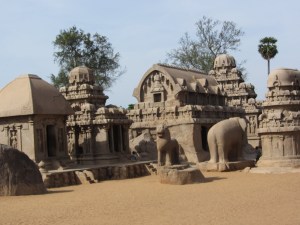
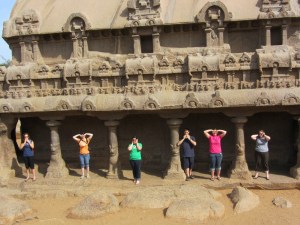

We had purposely gone early in the morning to beat the heat, but halfway through being out we were all cooked. It’s strange; most of us naturally have a lot of energy and act like Energizer bunnies, but in this heat everyone is a zombie. We hardly talk. The sun just sucks the power right out of you and you find yourself craving a nap right in the middle of the day. For those who know me well, you know I rarely ever nap. I’m almost opposed to them. But I’ve been falling asleep everywhere after spending just one hour in the sun.
I wonder what our group would be like if it was 70 instead of 95 every day.
We finished off the morning tour by going to a crocodile park and getting Subway. I was surprised to see “local flavors” for their footlongs which included chicken tandoori and chicken tikka masala as well as the normal turkey, ham and cheese and BMT. They even had a mint mayonnaise which tasted really delicious.
We spent the afternoon recovering, going for a walk/run (I really miss running more than 3o minutes but it’s just too damn hot) and steathily getting two cakes, chocolate and vanilla, for Kayla’s 25th birthday. At night we surprised her with a mini party complete with pizza and cake and even convinced Mutu, our caretaker, to come for dessert. He’s so used to doing things for us that he kept trying to give up his seat and refused food. But we eventually persuaded him to sit down and enjoy with us and he sang Kayla “happy birthday” in Tamil.
And that was yesterday.
Other than that, we’ve had nothing new happening. We start back up with our projects tomorrow, getting samples at the clinic in the morning, doing lab work in the afternoon and stopping in between for lunch and dinner. Things randomly break in our hostel (like the air conditioner or the fridge or the toilet) so we spend some time reporting problems to Mutu, doing chores like laundry and cleaning and switching off using the internet. It’s a simple life, which is very refreshing. Next weekend there are plans to go snorkeling on the tip of India and then visit Mudumali, the elephant sanctuary, the week after.
And now it’s time for some rooftop tanning and reading. More updates later.
>The Village People
>
I’ve finally returned from my 3 day trek over Tamil Nadu. Time for a long update.
On Monday, we woke at the heinous hour of 4:30am to get ready for our 6 hour journey. It’s strange to me that at the beginning of the summer (while shadowing at the lab), I’d sometimes be awake until this time, fooling around on the net or watching t.v.. Now, I’ve reverted to old person mode and go to bed between 9:30-11pm to wake up anywhere between 5-7a.
Since everything runs on Indian time, our air conditioned van arrived 45 minutes late. We’ve come to expect that things will not go according to plan here, as people run on their own schedules and things are a lot more laid back. “India will teach you patience” is the best and most accurate thing we’ve been told since arriving. My patience was certainly stretched to its limits many times on our 3 day journey, and I still struggle with the amount of waiting around that we do. But I think I’m getting better.
The first leg of our journey took us Southeast, to a region called Darmapuri (arrow 1 on the map). The temperature there is at least 5-10 degrees cooler since there aren’t huge buildings to stifle the wind and it’s a lot more open. The area also had a lot more foliage and a beautiful backdrop of hills and mountains. It finally felt like Asia, or at least the Asia that I had imagined for myself.
An example of some of the super narrow country roads…where the trucks like to play chicken
We stopped at a roadside vegetarian restaurant for brunch. The professors are very careful about what places we eat, since we’ve already had a brush with the unpleasant. Our digestive tracts still haven’t truly recovered from whatever we were hit with…we’ve even created an exclusive club: the LPC (liquid poo crew). Everybody wants in.
One of the animal nutritionists who traveled with us, Ashwari (shortened…her real name is more than 10 letters) explained to us that in India, vegetarians don’t eat any animals, fish or eggs but will still drink milk and eat dairy products. Pseudo-vegans, basically. It’s funny because they just assume that all Americans are meat eaters, and were very surprised to learn that one of our group is a vegetarian.
The professors attempted to surprise us after brunch by bringing us to the “Golden Temple” which is the site of worship for the Hindu goddess of wealth. Although the lines ended up being too long, when we exited the temple we were met by one of our biggest surprises yet. A man was leading a painted elephant around the premises. The elephant was trained to “bless” people when they paid a rupee by curling up her trunk and bonking them lightly on the head. We literally FREAKED OUT at the site of our first pachyderm and went running after it with rupees. The elephant was extremely gentle and sucked the rupees out of our hands with her trunk. That made the stop totally worth it.
Eventually, we arrived at the extension branch of the veterinary school and met up with the other researchers. They honored us by allowing us to plant baby palm trees in the back of the school, and promised to send us pictures of the grown trees in about 3 years. From there we moved on to the first of the milk districts that we would visit during the next 3 days. The milk districts are made up of little villages which lie off the beaten path where nearly every house owns a cow or two. The residents pool all of their milk and sell it to the local collectors, and this keeps their families and village running. The villagers depend on the cows for their own lives, which is part of the reason why Indians revere cows as holy. Many villagers also keep buffalo (not holy, for some reason), goats and chickens as well as a dog or two to protect the household. Goats are considered walking bank accounts, since they can be sold for meat in times of need. Buffalo produce milk that has a higher fat content than cow’s milk, so their product reaps a higher profit (although they may not produce as much).
A milk collection center
As soon as we got to our first village, the people started piling out into the streets and the staring began.
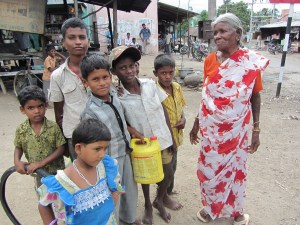 I don’t really mind when the children or the villagers do this (since they rarely seem to get out and probably don’t see too many white people), but when the adults in the cities stare, it eventually gets on my nerves. People know better than to continue to stare for 5 minutes, even if we do look weird. One guy in Chennai even achieved mega creeper status and kept moving to stand near our group, totally invading our collective bubble.
I don’t really mind when the children or the villagers do this (since they rarely seem to get out and probably don’t see too many white people), but when the adults in the cities stare, it eventually gets on my nerves. People know better than to continue to stare for 5 minutes, even if we do look weird. One guy in Chennai even achieved mega creeper status and kept moving to stand near our group, totally invading our collective bubble.
But I digress.
The houses are built of what looks like clay or stone and painted bright colors, with open doors and windows. Some houses have roofs made of dried palm leaves. They range in size from one bedroom to large, multi-room households with TVs and satellite dishes where the richer folks reside.
One of the nicer farm houses, complete with satellite dish
One house that we visited (probably with the only real bathroom in town) had marble floors. Even in the villages, the uneven distribution of wealth was evident. But still, the friendliness of the people was the same across the board, and we were offered tea, coconut milk and a variety of other food over the time that we spent there. We even got to try a traditional Indian snack of unripe mango, which is more like a vegetable than a fruit. They cut it up into slices, dip it in salt and mild chili powder and eat it like a crunchy French fry. Unfortunately, eating these unripe and unpeeled mangos broke one of the three traveler’s commandments:
1. Don’t drink the water
2. Don’t eat anything that you can’t peel
3. Don’t eat raw vegetables or anything from a street vendor (unless you know them personally)
Hopefully we won’t be paying for it later.
The villages are pretty much self contained units, each with what looks like a school (or at least a school nearby), a place to hang out, a place to get water and a place to bring your milk and other goods. The children run and bike around the streets and many people have motor bikes. There were a lot less cars and a lot more bullock-drawn carriages. Bullocks are castrated male cattle with huge, painted horns that are strapped up to yolks and used to pull carts around. In each house, entire families would live together, including the grandmother and grandfather, immediate family and relatives. A lot of the older women were silent and tiny, and many sported double nose piercings. The most memorable older woman I saw seemed nearly blind and was in charge of a giant compost pile near the one cattle chute in town. While we were collecting samples from the cows in the chute, she would scrape up the manure with her BARE HANDS (literally scraping the ground with her nails) and toss it into the compost pile. There were things that could have been used as shovels…I have no idea why she chose to use her hands. That woman was exxxxxxtreme.
The children were especially fascinated by us. Literally everywhere we went in every village, there was a little band behind us, watching our every move. If you smiled or waved at the girls, they’d run away or start giggling, and the boys would push each other towards us. One even took a million pictures of us on his cell phone. Many of the children knew some English words, and were thrilled when you talked to them or asked them questions. They were especially excited if you spoke any Tamil (the native language). Some words we’ve learned (probably not spelled right):
Nandri- thank you
Adu- goat
Mardu- cow
Coti- chicken
Yani- elephant
The children would go running around pointing at the animals and saying these words until you pronounced it right. It was very cute. One of them asked me where my village was, and knowing that Massachusetts would be a difficult word for them to pronounce, I simply wrote “Boston, America” on my notebook. They could pronounce that. Soon we were all drawing pictures for the children, which they’d fight over and run away with. Another girl started calling us “famous girls” in Tamil, and it certainly felt that way. Every time we clambered back on to our van to go to the next village, the people would all come swarming up to wave goodbye and yell to us.
Drawing for the kids
At all of the villages, our job was to collect information about the cows using a survey and gather samples of rice gruel, bran, and whatever other types of food the farmers chose to feed their animals. We’d then give them a bag of the mineral mix to try out for two weeks before we returned to collect subsequent samples. Each house had at max of about 4 cows, with some only having one. The cows were usually tied to immovable objects in the yards and left to stand around and think about whatever cows think about. In general, they looked alright, albeit a bit skinny. But some things made no sense to me, such as the fact that many of the cows had no water to drink. They didn’t seem dehydrated, but it only makes sense that if milk is about 80% water, they should be supplied with a constant source. And it’s not that there was no water to give; some farms even had their own springs or wells. One particularly pretty house nestled in the back of a big field of tapioca plants had a square trench dug into the ground for water and something like a moat going around the back of the house. Supplying continuous water to the beasts would be such a simple way to improve production. And providing shade wouldn’t hurt either.
A cow eating her gruel
After collecting samples from about 35ish animals, we finally quit around 9pm at night. Exhausted, we checked into the hotel and tried to get some sleep. Tuesday was very similar, collecting samples in the morning, traveling in the afternoon (to Pondicherry- #2 on the map) and getting more samples at night. We knew that Pondicherry would be a good place when we arrived at the hotel and found American style toilets rather than the customary Asian “hole in the ground” variety. With those toilets, the “flush” requires you to manually pour some water down the hole, and no one uses paper. It’s pretty awkward.
Pondicherry is a charming place on the coast of India which used to be an old French settlement (a large portion of the current residents of Paris descended from the French in Pondicherry). The name literally means “new village”. On Wednesday, we finished the last of the collections (about 60 total for the whole trip) and spent the rest of the day touring around this historical spot.
Our tour was lead by a very charismatic Indian vet who is married to one of the animal nutritionists from Madras Vet School. He spoke English better than nearly all of the people we met over those three days, so it was very refreshing to talk to him. He wore a pair of snazzy yellow Ray Ban aviators that I eyed admiringly. When I finally told him that I liked them, he took my own cheap aviators off my head and put them on. He then offered to let me keep the Ray Bans.
Indians are too nice for their own good.
I felt too guilty to keep them, but I swore to myself that I’d eventually get my own pair (when I win the lottery).
Dinner in Pondi was orgasmic. We were directed to a French and Italian style restaurant located down a back alley with a huge outdoor seating area and giant comfy chairs. After hours on our feet collecting samples in the heat, sitting down to a cold Fosters, an Italian meal and non-spicy food was better than anything we could have asked for.
Drool
Double drool- pesto covered red snapper with mashed taters and veggies
The temperature was perfect, the company was good and the restaurant was extremely cozy and well decorated. We even finished off the meal with crème brulee. A British couple next to us lazily smoked cigarettes and drank beer, chatting about their own travels. It was like a scene out of a book- exactly what I was hoping for from Pondicherry.
Afterwards, we visited an ashram, which doesn’t really have an English word equivalent. It basically means “a place to meditate, be at peace and think.” This ashram was started by a religious figure called The Mother, who was a very wise woman who wrote a lot about meditation and life in general. I didn’t catch her whole story but I plan on reading more about her when I have regular internet access.
We were told to take our shoes off, turn off our cellphones and leave our cameras outside when we entered the ashram since it is a very serious and holy place. Inside, it was so strangely quiet, and the atmosphere was almost thick? with concentration. Our guide described the phenomenon as “feeling the waves of concentration” between all of the people meditating. It was weird, in a good way. We sat for a bit and took in the atmosphere. No one stared at us. They were all enjoying their own thoughts.
After a brief stay there, we moved on and ended up walking around a place called Auroville which is home to a huge golden, golf ball shaped temple. It was after visiting hours, so we decided to come back on our next trip to Pondicherry (in about 2 weeks for more sampling). I’m sure I’ll be writing more on that later.
Commuters near Auroville
Our guides at the temple- check out the Aviators 😉
Our final stop was the Ganesh (elephant God) temple back near the French quarter. In that temple we were able to see the golden statues of Ganesh and witnessed the priests blessing people and leaving offerings. It was a very strange system…I wasn’t really sure what to make of it. The inside of the temple was beautiful, but also seemed strangely like a mall, with people leaving rupees at different stands and paying for coconuts and leaves to offer to Ganesh (after all, he is an elephant god). There was even a golden and silver chariot attached to a trailer hitch which Ganesh “travels in” that people could rent out for special occasions. I guess donations are a part of every religion, but it just seemed odd to me that so much of the prayer and worship revolved around money. On the way out, we were again blessed by the temple’s elephant, who stood outside on a big platform.
She was just as gentle as the first elephant we saw, and was ridden home to sleep for the night by one of the men who was in charge of her. He just hopped on, no big deal, and took her for a leisurely stroll back down the streets of French quarter to wherever she slept.
A piece of French quarter
While we waited for our van to pick us up, we walked barefoot to the beach and made friends with another street dog.
 The beach reminded me a lot of Salisbury beach in New Hampshire, which was comforting in its own way. Same amount of trash, same number of vendors and people. Not the same smells, but still very much like Salisbury. The van eventually got us, and we headed back to our home sweet hostel.
The beach reminded me a lot of Salisbury beach in New Hampshire, which was comforting in its own way. Same amount of trash, same number of vendors and people. Not the same smells, but still very much like Salisbury. The van eventually got us, and we headed back to our home sweet hostel.
And that pretty much sums up my life during the past 3 days. Today, we were forced to visit the immigration office since there was a minor hiccup with our visas. Apparently we aren’t supposed to be doing any kind of research since we bought tourist rather than student visas. But all is fixed now. Other than that, we made yet another trip to the mall where we got a bunch of gifts and were harassed by shop owners. You have to learn to haggle with them to get the price you really want. Being foreign places a big “gullible” sign on your head and people will take your money, no problem. We’ve learned that if you just name your price and play hard to get (literally exiting the store if they say no), they will come running after you with the exact price you wanted just a minute later. You’ve just gotta be firm and stick to your guns.
In other news, I was super excited to discover that the creator of the RB-51 vaccine for brucellosis is currently living across from us in the guys’ hostel!! He is an Indian veterinarian visiting for some reason or other, and I nearly asked for his autograph when I found out. This probably isn’t very exciting for you non-vet people, but for me it was like meeting a celebrity.
In other other news, we finally found a place that sells real, American style cookies. We all have a bit of a sweet tooth, and as such have been searching for some good desserts besides the chocolate bars you can buy in the local convenience store. (BTW, they also sell Kinder Eggs, the candy with a toy in the middle that were banned in the US due to toddlers choking on them). A lot of the things that Indians call cookies are really just spicy crackers. At the mall, we discovered a sweets shop with real chocolate chip cookies. At 40 rupees a pop ($1 American for one cookie) they were a bit overpriced, but totally worth it. We eventually noticed that the logo of the company had a little British flag in it, which probably explains the priceyness.
Also…besides finding real cookies, one of the best parts of my week was discovering that we can indeed see Harry Potter 7, Part II in ENGLISH on the day it’s released!! I swore to myself that I would wait if I could only see it with subtitles, because I wanted the entire experience (including Daniel Radcliffe’s nasally voice). But we can indeed see it in all its glory!! WOO HOO! Annd I’ll be able to see it a whole 9.5 hours earlier than you Americans :P. Don’t worry, I won’t ruin any of the surprises.


